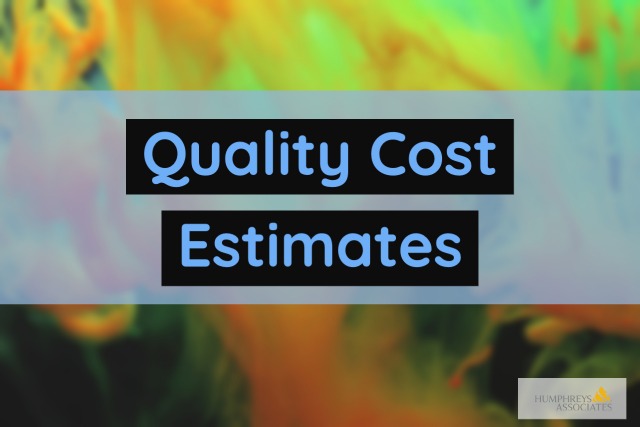
The Foundation for a Realistic Performance Measurement Baseline (PMB)
If you have been involved in an Integrated Baseline Review (IBR), you can appreciate why a clear understanding of the project’s contractual scope of work and technical requirements is so important. Without that understanding, it is impossible to create an executable Performance Measurement Baseline (PMB). The intent of the IBR is to demonstrate to your customer you have created a realistic schedule and cost baseline plan that reflects a shared understanding of the work scope requirements as well as identified technical, schedule, cost, or resource risks that may impact the ability to execute the work as planned.
So, how do you demonstrate to your customer that your schedule and cost baseline plan is realistic for the agreed upon scope of work? That’s where the quality of the cost estimate and related basis of estimate (BOE) information come into play. The quality of the PMB is a direct reflection of how the project control team arrived at their cost estimate for the work scope along with documented BOE details that clearly communicates their rationale and assumptions. The project control team needs this foundation to define the project’s sequence of activities, durations, and resources to do the work that reflects the known requirements and identified risks.
What are the characteristics of a quality cost estimate?
A quality cost estimate:
- Reflects a shared understanding of the scope of work and technical requirements. This is often the root cause of an unrealistic cost estimate. The IBR is a perfect opportunity for all parties to confirm the customer’s requirements and expectations.
- Is data driven. That means the proposal or project control team has access to relevant historical actual costs for analogous tasks, parametric data, or other documented and substantiated basis for the cost estimate. The source data for the cost estimate can be traced back to the system of record, internal standards for completing common repeatable tasks, or published industry standards. Where possible, the use of engineering judgement cost estimating methods is minimized because they introduce a level of unknowns. The risk of cost growth increases because objective facts and data aren’t available for other people to verify the cost estimate rationale or assumptions are reasonable.
- Includes useful documented rationale with risk/opportunity assessment. The BOE should capture what source data was used for the cost estimate, why it was relevant, assumptions, what factors or other calculations were used to arrive at the cost estimate, what is included or excluded, identification and evaluation of likely risks and opportunities, and other details useful for explaining the cost estimate. This is invaluable information the project control team needs to create a realistic schedule and cost baseline. This rationale, or clearly documented rationale someone else can follow, is frequently the missing piece. Lack of useful documented rationale can handicap the project control team during the planning phase right after contract award – and for the duration of the project.
How do quality cost estimates help improve the PMB?
The project control team, project manager, and the customer need quality cost estimates and useful documented rationale so they can verify:
- The integrated master schedule (IMS) sequence of activities, resource assignments, and skill mix reflect how the project teams intend to do the work as well as handle identified risks and opportunities.
- Sequence of schedule activities and resource assignments are the foundation for the time phased budget.
- The appropriate level of schedule margin and management reserve are established for the project.
- Useful earned value techniques are selected for the activities and work packages. In addition to technical requirements, the BOE documentation can often provide additional details that can help the project control team define accomplishment criteria or quantifiable backup data so it is easier to objectively measure completed work.
These cost estimates and documented rationale are also invaluable for:
- Variance analysis and identifying why significant deviations from the baseline plan occurred – whether in work performance or actual costs incurred to do the work. Did an unexpected event occur? Perhaps the risk assessment process needs a revisit. Were the assumptions incorrect? Why did that happen and what could be done differently to either capture or clearly communicate those assumptions?
- When the project control team needs to process a baseline change request. They can review the source data, rationale, and assumptions to identify what was different from what actually occurred. Or, in the case where there is a change in the scope of work, the project control team can identify the cost estimate and BOE factors they need to update to reflect the revised scope of work. It provides a fact-based foundation to explain why the change was required and to determine what updates need to be made to the schedule activities, resource assignments, and time phased budget.
- Providing fact-based information useful for maintaining a credible estimate to complete so it more accurately reflects the likely completion date and estimate at completion whether for interim deliverables or the entire project.
- Rolling wave planning. As more becomes known about the future work requirements, the cost estimate and BOE can be refined to reflect the agreed upon statement of work, assumptions, risk and opportunity assessments, and other details needed to adequately plan, budget, and manage the work.
Cost estimate quality improves with each project.
A realistic PMB reduces the likelihood of schedule and cost growth “surprises” that negatively impact a company’s bottom line or the customer’s program budget. As work is completed, the performance and actual cost data become useful historical source data for the next proposal or project. Each cycle improves the quality of the source data proposal or project control teams can use to substantiate their cost estimates and produce useful BOE documentation for the next project’s PMB.
Need help with preparing for an IBR or standardizing your process for producing cost estimates and BOE rationale? Contact us today.